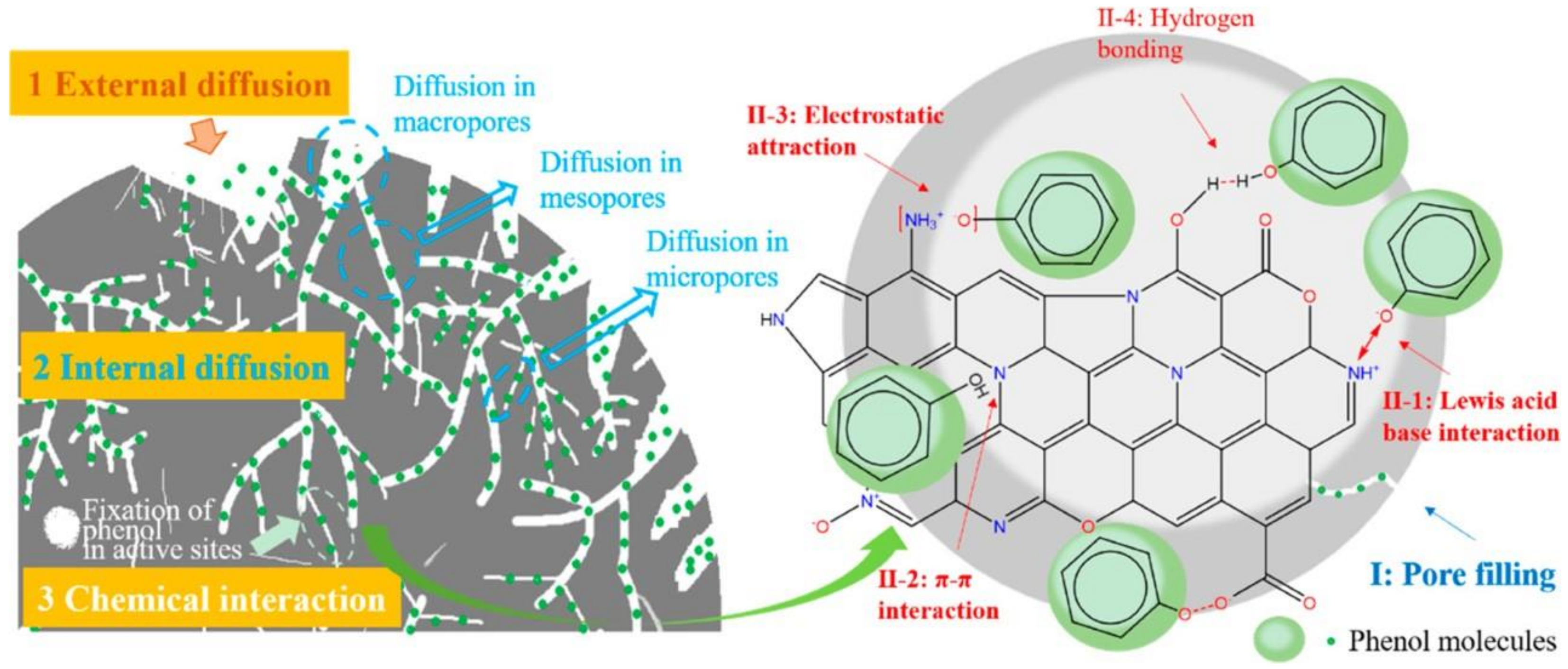1000/1000
Hot
Most Recent

| Version | Summary | Created by | Modification | Content Size | Created at | Operation |
|---|---|---|---|---|---|---|
| 1 | Wen Da Oh | + 3982 word(s) | 3982 | 2022-02-18 11:37:15 | | | |
| 2 | Vicky Zhou | Meta information modification | 3982 | 2022-02-21 05:16:47 | | | | |
| 3 | Vicky Zhou | + 1 word(s) | 3983 | 2022-02-21 05:19:50 | | | | |
| 4 | Vicky Zhou | -20 word(s) | 3963 | 2022-02-23 07:19:55 | | | | |
| 5 | Vicky Zhou | + 20 word(s) | 3983 | 2022-02-23 10:45:55 | | |
Biochar is a biological material for environmental remediation due to its low-cost precursor (waste), low toxicity, and diversity of active sites, along with their facile tailoring techniques. Due to its versatility, biochar has been employed as an adsorbent, catalyst (for activating hydrogen peroxide, ozone, persulfate), and photocatalyst. Biochar could also be applied in remediation of organic pollutants in water.
 Figure 1. Mechanism of phenol adsorption by N-doped biochar. Reprinted with permission from Li et al.[14]. Copyright 2019 American Chemical Society.
Figure 1. Mechanism of phenol adsorption by N-doped biochar. Reprinted with permission from Li et al.[14]. Copyright 2019 American Chemical Society.| Biochar Precursor and Synthesis |
Performance | Removal Mechanism | Ref |
|---|---|---|---|
|
|
|
[26] |
|
|
|
[27] |
|
|
|
[28] |
|
|
|
[29] |
|
|
|
[30] |
|
|
|
[31] |
|
|
|
[32] |
|
|
|
[33] |
| Biochar Precursor and Synthesis |
Performance | Removal Mechanism | Ref |
|---|---|---|---|
|
|
|
[36] |
|
|
|
[37] |
|
|
|
[38] |
|
|
|
[39] |
|
|
|
[40] |
|
|
|
[41] |
|
|
|
[42] |
|
|
|
[43] |
| Biochar Precursor and Synthesis |
Performance | Removal Mechanism | Ref |
|---|---|---|---|
|
|
|
[46] |
|
|
|
[47] |
|
|
|
[48] |
| Biochar Precursor and Synthesis |
Performance | Removal Mechanism | Ref |
|---|---|---|---|
|
|
|
[49] |
|
|
|
[50] |
|
|
|
[51] |
|
|
|
[52] |
|
|
|
[53] |
|
|
|
[54] |
|
|
|
[55] |
|
|
|
[56] |
|
|
|
[15] |
|
|
|
[57] |
|
|
|
[58] |
| Biochar Precursor and Synthesis |
Performance | Removal Mechanism | Ref |
|---|---|---|---|
|
|
|
[65] |
|
|
|
[65] |
|
|
|
[66] |